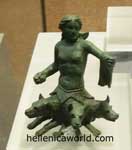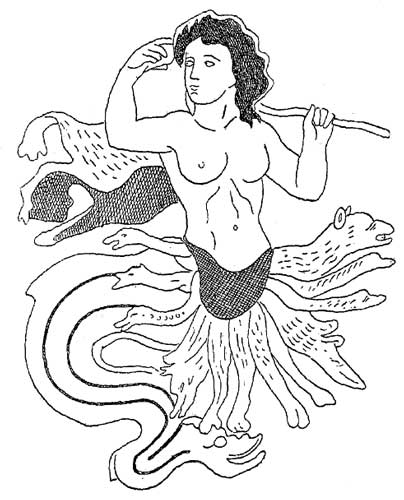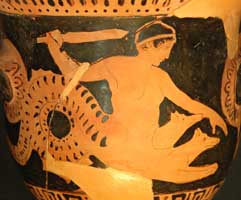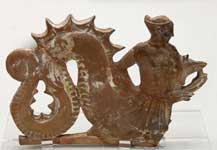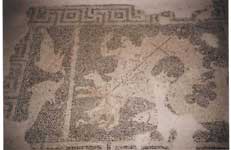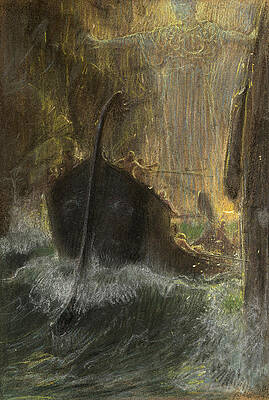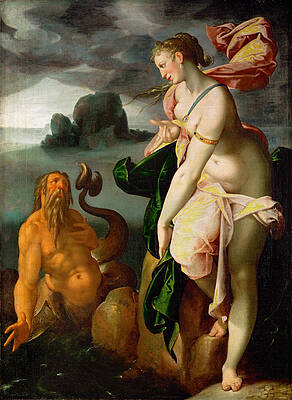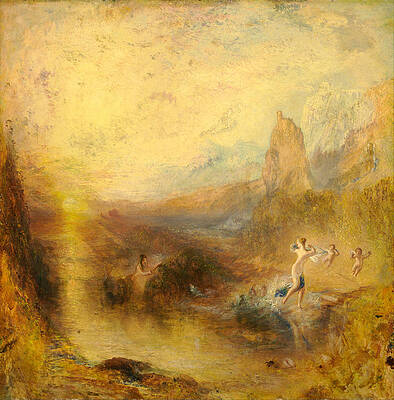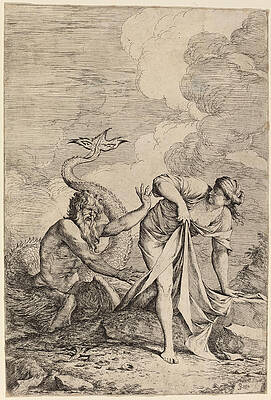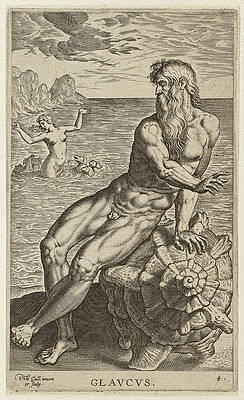.
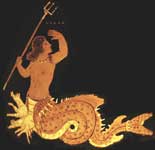
It's true her voice sounds like a new-born pup,
but she's a vicious monster. Nobody
would feel good seeing her, nor would a god
who crossed her path. She has a dozen feet,
all deformed, six enormously long necks,
with a horrific head on each of them,
and three rows of teeth packed close together,
full of murky death. Her lower body
she keeps out of sight in her hollow cave,
but sticks her heads outside the fearful hole,
and fishes there, scouring around the rock
for dolphins, sword fish, or some bigger prey,
whatever she can seize of all those beasts
moaning Amphitrite keeps nourishing
in numbers past all counting. No sailors
can yet boast they and their ship sailed past her
without getting hurt. Each of Scylla's heads
carries off a man, snatching him away
right off the dark-prowed ship. The Odyssey: Book 12
In Greek mythology, Scylla, or Skylla (Greek Σκύλλα) was a name shared by two beings:
Scylla was the Princess of Megara, daughter of King Nisus who was invincible as long as a lock of red hair still existed, hidden in his white hair. King Minos of Crete attacked Megara but Nisus knew he could not be beaten because he still had his lock of red hair. His daughter, Scylla, fell in love with Minos and proved it by cutting the red hair off her father's head. Nisus died and Megara fell to Crete. Minos killed Scylla for disobeying her father. She was changed into a seabird, relentlessly pursued by her father, who was a sea eagle.
-------------------
Scylla, the daughter of Crataeis, is one of the two sea monsters in Greek mythology (the other being Charybdis) which lives on one side of a narrow channel of water. The two sides of the strait are within an arrow's range of each other, so close that sailors attempting to avoid Charybdis will pass too close to Scylla and vice versa. The phrase between Scylla and Charybdis has come to mean being in a state where one is between two dangers and moving away from one will cause you to be in danger from the other. Traditionally the aforementioned strait has been associated with the Strait of Messina between Italy and Sicily but more recently this theory has been challenged and the alternative location of Cape Skilla in north west Greece suggested. Scylla has the face and torso of a woman, but from her flanks grow six dog heads and her body below that sprouts twelve canine legs and a fish's tail. She was one of the children of Phorcys and Ceto known as the Phorcydes.
She's not human,
but a destroyer who will never die—
fearful, difficult, and fierce—not someone
you can fight. There's no defence against her.
The bravest thing to do is run away.
If you linger by the cliff to arm yourself,
I fear she'll jump out once more, attack you
with all her heads and snatch away six men,
just as before. Row on quickly past her,
as hard as you can go. Send out a call
to Crataiis, her mother, who bore her
to menace human beings. Homer, Odyssey, Book 12
In Homer's Odyssey, Odysseus successfully navigates his ship past Scylla and Charybdis.
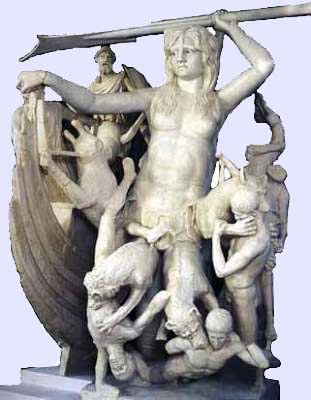
The sea monster Scylla from Sperlongs
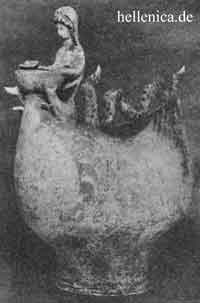
Scylla Vase from Italy
Glaucus and Scylla, Laurent de La Hyre
Between Scylla and Charybdis, Adolf Hiremy-Hirschl
Glaucus By Turning Scylla Into A Monster Print by Eglon van der Neer" src="https://render.fineartamerica.com/images/images-profile-flow/400/images/artworkimages/mediumlarge/1/circe-punishes-glaucus-by-turning-scylla-into-a-monster-eglon-van-der-neer.jpg" alt="Circe Punishes Glaucus By Turning Scylla Into A Monster Print by Eglon van der Neer" />
Circe Punishes Glaucus by Turning Scylla into a Monster, Eglon van der Neer
Glaucus and Scylla, Bartholomeus Spranger
Glaucus and Scylla, Joseph Mallord William Turner
As retold by Thomas Bulfinch, Scylla was originally a beautiful nymph. She scorned her many suitors and chose to live among the Nereids instead, until one day Glaucus saw and fell in love with her. Glaucus was a mortal fisherman who had previously been transformed by chewing a plant, gaining the form of a fish from his waist down. When Glaucus declared his love to Scylla she fled, taking him for a monster. Glaucus sought the help of Circe, hoping that this witch could make Scylla to love him with her herbs, but Circe fell in love with Glaucus herself and asked him to forget Scylla. Glaucus rejected her request, declaring that his love for Scylla was eternal.
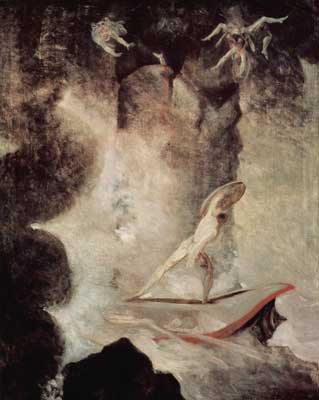
Odysseus between Scyla and Charybdis, Johann Heinrich Füssli, 1794-1796
Circe was enraged by Glaucus's refusal, and turned her anger on the girl whom he loved. She went and poisoned the water which Scylla used to bathe with her magical herbs. When Scylla waded into the water, the submerged half of her body was transformed into a combination of fish joined with six ferocious dogs' heads sprouting from around her waist. The dogs attacked and devoured anyone who came near, beyond her ability to control, and Scylla fled to the shore of the strait to live there alone.
It is said that by the time Aeneas's fleet came through the strait after the fall of Troy, Scylla had been changed into a dangerous rock outcropping which still stands there to this day.
Scylla and Charybdis are believed to have been the entities from which the term, "Between a rock and a hard place" (ie: a difficult place) originated.
Glaucus and Scylla, Salvator Rosa
The sea god Glaucus, seated on a shell. In the background the nymph Scylla, Philip Galle
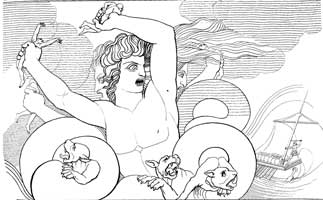
Scylla, John Flaxman, 1810

Scyla and Charybdis, Asmus Jacob Carstens
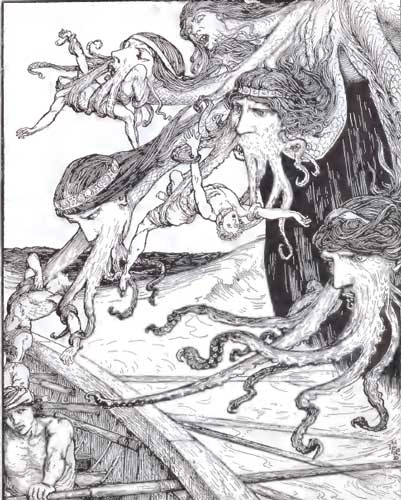
Scylla
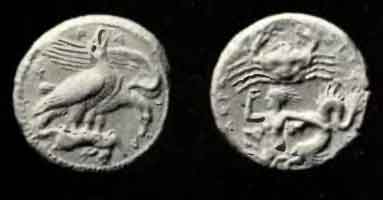
Akragas Tetradrachm, two eagles with a hare, the monster Scylla and a crab, Text AKRAGANTINON, Scylla is a genus of crabs, including the mangrove crab Scylla serrata.
Link
- Bulfinch's retelling of the myth of Glaucus and Scylla
- detail—red-figure kalyx krater depicting Scylla: (rest of vase depicts Zeus, Europa, Triton) Greek, from Paestum, in southern Italy; c. 340 BC
- Sperlonga Scylla
155 Scylla is an asteroid.
The Odyssey, Homer , Robert Fagles (Translator), Bernard MacGregor Walke Knox (Introduction)
See also : Greek Mythology. Paintings, Drawings
| Ancient Greece
Science, Technology , Medicine , Warfare, , Biographies , Life , Cities/Places/Maps , Arts , Literature , Philosophy ,Olympics, Mythology , History , Images Medieval Greece / Byzantine Empire Science, Technology, Arts, , Warfare , Literature, Biographies, Icons, History Modern Greece Cities, Islands, Regions, Fauna/Flora ,Biographies , History , Warfare, Science/Technology, Literature, Music , Arts , Film/Actors , Sport , Fashion --- |
Retrieved from "http://en.wikipedia.org"
All text is available under the terms of the GNU Free Documentation License

